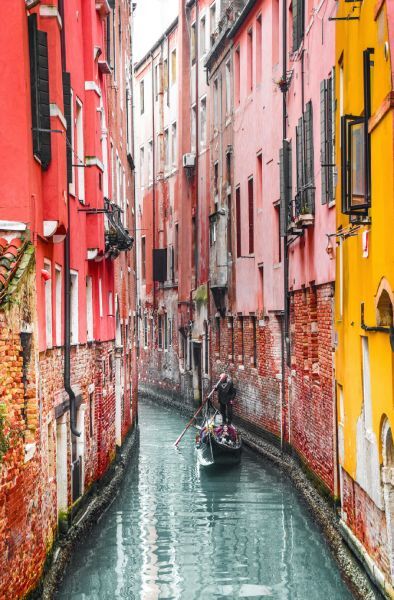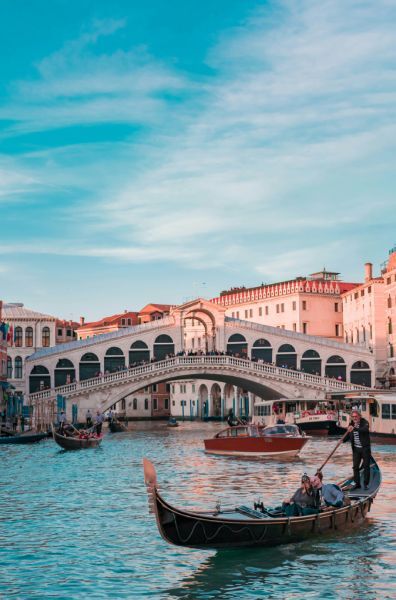One cannot help but be captivated by the intricate network of waterways that form the backbone of Venice, a city like no other in the world. For the uninitiated or those planning a visit, a deeper understanding of these canals can significantly enhance the experience. With its unique landscapes and historic ambiance, knowing more about the waterways, including their depth, the numerous bridges that arch over them, and the possibilities of swimming, offers a fuller appreciation of this splendid city. For a more detailed resource and to get your journey started, consider exploring our in-depth guide on traveling through Venice.
How Deep Are the Canals in Venice?
The question of depth in Venice’s canals piques the curiosity of many. Unlike a uniform body of water, the depth of Venice’s canals varies significantly. On average, the canals in Venice are about 1.5 to 2 meters deep. The Grand Canal, which is one of the major water routes in Venice, is slightly deeper, averaging about 5 meters in depth. It’s crucial for the waterways to maintain these depths to accommodate the range of boats that traverse the city — from the humble gondola to the more robust vaporettos, which are the city’s primary mode of public transport.
Maintaining these depths is no easy feat, given that Venice faces issues like siltation, which can lead to shallower waters. Therefore, periodic dredging is essential to ensure that boats can move freely without the risk of getting stuck. The Venetian authorities stay vigilant, overseeing these depths to preserve the functional integrity of their marine pathways.
The Bridge Network of Venice
Venice wouldn’t be Venice without its stunning bridges, each telling a story of its own. The city boasts over 400 bridges, each connecting the 118 small islands that make up this archipelago. The most renowned among these is the Rialto Bridge, which spans the Grand Canal and offers one of the most picturesque views in the city. The bridges not only serve the functional purpose of connectivity but are also intrinsic to the city’s charm and history.
These structures vary from the ornate, such as the Bridge of Sighs, enveloped in romantic and melancholic lore, to more simplistic and utilitarian designs found in residential districts. The engineering and architectural care taken in their construction reflect Venice’s response to practical challenges through artistic expression.
Swimming in the Canals of Venice
Though swimming in the canals might seem like an enchanting idea, it is generally advised against. The reasons are primarily related to safety and health. The water quality in the canals is not consistent and can pose health risks due to pollutants. Furthermore, the traffic of boats makes the canals a dangerous place to swim, as currents and waves created by motorized boats can prove hazardous to swimmers.
However, for those looking to plunge into water in Venice, there are more suitable options available. During specific events like the “Vogalonga” rowing regatta, swimming might be safer when boat traffic is restricted, and community involvement is high. Moreover, the city occasionally organizes official swimming events where participants can safely experience the waters under monitored conditions.
The canals of Venice are not merely channels of water; they are the lifelines of the city. They represent Venice’s adaptive architecture and its residents’ resolve in maintaining their city’s cultural heritage and structural integrity. As you walk alongside or glide through these canals, you’re experiencing centuries of history, each corner and curve narrating tales of bygone eras.
From fostering trade in the historic times to becoming major tourist attractions that support the city’s economy today, Venice’s canals have played an integral role in shaping the destiny of this floating city. Whether it’s the shallowest secondary canals that only see occasional gondolas or the deep and bustling Grand Canal, each has its significance and charm, contributing to the canvas that is Venice.



Essential FAQs about Venice and Its Iconic Canals
How deep are the Venice canals?
Most canals in Venice have an average depth of about 1.5 to 2 meters (5 to 6.5 feet).
Is the tap water in Venice, Italy, OK to drink?
Yes, the tap water in Venice, Italy, is safe to drink and visitors are encouraged to refill their water bottles from public taps.
Do you tip gondola drivers?
Tipping is not mandatory but is appreciated. A tip of 5-10% of the ride cost is customary if you enjoyed the experience.
Are gondolas in Venice cash only?
Previously, most gondola transactions were cash-only, but nowadays, many gondoliers accept electronic payments as well.
Is Venice saltwater or freshwater?
The Venetian Lagoon where Venice is situated is a mix of saltwater and freshwater, influencing the ecosystem around the city.
How deep is the water under Venice?
The water depth varies across the lagoon but averages around 10 to 20 meters at its deeper navigable routes.
Why is Venice built on the water?
Venice was founded by people fleeing barbarian invasions on the mainland during the 5th century. The islands of the Venetian Lagoon provided a defensible and strategic base, necessitating the development of robust maritime capabilities.
Venturing through Venice, with its iconic canals, historically significant bridges, and the melodic rhythm of oars dipping into the water, is akin to stepping into a living museum. Remember, while it’s tempting to dip your toes into these fabled waters, enjoying them from a boat or from the sidelines is both safer and respects the city’s ongoing conservation efforts. The canals of Venice are a testament to human ingenuity and nature’s endowments, often leaving visitors in awe of its serene yet vibrant character. So, pack your bags, but before you do, don’t forget to visit our comprehensive guide to Venice, which awaits to prepare you for a journey of a lifetime.



